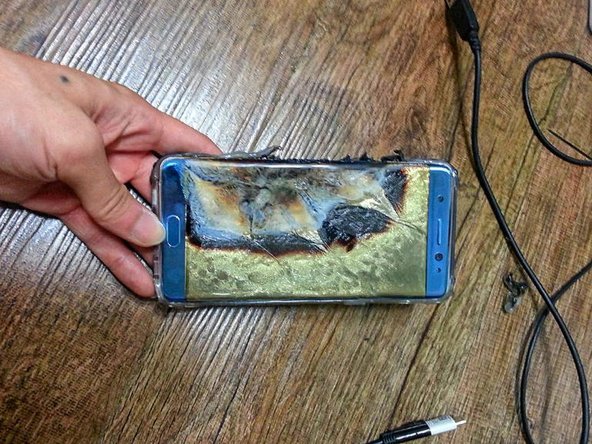Lithium-ion batteries will kill us all. Okay, maybe that’s a tad dramatic. But batteries can definitely be lethal—and they’re definitely inside a lot of the things we own: electric cars, smartphones, cameras, and even children’s toys. Nevertheless, lithium-ion batteries have largely stayed out of the limelight—up until the onslaught of battery crises in recent years. But we think that lithium-ion batteries still don’t get the attention that they deserve—because if they’re in everything we own, we ought to know how they work, and what potential risks they pose.
That’s why we’re declaring this week, Battery Week. Every day this week, we’ll be publishing new blogs and videos to educate you on everything you ever wanted to know about the batteries in iPhones—how they work, what to do when they swell, how to safely recycle them, and how to replace them yourselves. We’ll even be live-streaming a battery swap with one hand tied behind Kelsea’s back —because if Kelsea can replace a battery with one hand, then you can certainly do it with two.
But first—here’s a little primer on the history of the 3 biggest lithium-ion battery scandals to really get us in the mood:
1. The Great Hoverboard Crisis
Just before Christmas 2015, the season’s hottest toy got quite a bit hotter—lithium-ion batteries inside of hoverboards started spontaneously catching fire. By July of 2016, the US Consumer Product Safety Commission reported at least 60 known hoverboard-related fires totaling over $2 million in damages. And these fires occurred in all kinds of hoverboards—so there’s not one manufacturer to blame for shoddy design, or a bad batch of batteries. Being the safety (and sometimes tacky) nerds that we are, we even created a “smother bag” to give consumers an on-the-go solution for hoverboard fires. But, all jokes aside, the Great Hoverboard Crisis of 2015 finally put lithium-ion batteries on the map—skull and crossbones, safety hazard-style.
2. Note7: Catching Fire
Fast forward to September 2016, when at least 35 Note7 battery explosions were heard around the world (wide web). It wasn’t until Note7 devices started catching fire that the danger of lithium-ion batteries became truly ubiquitous. The debacle carried on for months, so here’s a quick TL;DR:
September-December 2016
- After reports of Note7’s catching fire, Samsung recalled select Note7 devices and promised to exchange them with a new model including a different battery.
- Replacement Note7’s started catching fire, too. Whoops! So Samsung recalled the entire Note7 line and halted production.
- The DoT stepped in and banned Note7 devices from all flights. Samsung provided airports with kiosks where Note7’s could be deposited.
- The world stopped selling Note7 phones and Samsung requested that local carriers cut service to Note7’s. Samsung pushed an update to all extant Note7 devices, bricking them to prevent their use.

So what happened exactly? Without getting super-scientific, the batteries in the Note7 were essentially defective. Samsung pushed the Note7’s battery capacity to the limit—along with its production speeds, and manufacturing tolerances—without corresponding quality controls. And when you leave no margin for error, you’re playing with fire. Literally. The smallest mistake can be catastrophic—like $5 billion kinda catastrophic—which is what Samsung estimated they lost from the recall. We suspect that’s why Samsung released their refurbished Note7 Fan Edition a year later with a smaller battery capacity (12.32 Wh vs. 13.48 Wh).
And not to be that guy, but how much cheaper could this recall have been for Samsung if they kept their removable battery design of yore? Just pop the battery out, replace it with a new one, and you’re done!
3. Batterygate: Apple’s iPhone Throttling Conspiracy
The most recent battery scandal to make headlines had nothing to do with fires at all. In December of 2017, Apple admitted to intentionally degrading the performance of iPhones equipped with older batteries. Since 2016, reports had been pouring in detailing reliability issues, usability problems, and sudden shutdowns for older iPhones. Of course, public outcry and lawsuits ensued. And in January of 2018, Apple attempted to mitigate the damage by offering $29 battery replacements for iPhones 6 and newer for the duration of 2017. To serve iPhone users unable to reach Apple stores, we matched the offer and cut the prices on all of our DIY iPhone battery kits to $29 or less. Plus, we included options for the iPhone 4S, 5, 5s and 5c (which are excluded from Apple’s new program).
The future of lithium-ion batteries
If lithium-ion batteries are so dangerous—and if manufacturers can even use them to tamper with our devices—then why do we put them in everything? Well, they’re pretty darn efficient. Pound for pound, they pack a high-energy density that alternative batteries simply can’t reach—yet. They’re also much lighter than other types of rechargeable batteries, which makes them a perfect solution for hand-held devices. But as lithium-ion batteries become even more pervasive, and until we find a safer and more efficient alternative, it’s important to be aware of their potentially harmful side effects. Knowledge is power after all!




0条评论